???? ?????
Lavih Serfaty in Hamburg
Lavih Serfaty is an Israeli artist and his works reflect the turbulus area of the Middle East. War, terror, teritories,
landscape, urbanic tragedies, colors, compositions, movements, people, cities
and villages, all is restless and always in movement, like a fortissimo musique.
The sky is taking part of the painting as a rivale of the earth. There is always
a debate between the sky against the earth, the city against the mountains, the
villages against the desert, the people against the nature and against
themselves.
Lavih is a multicultural artist, born in Casblanca, Morocco in 1945: "My childhood was
very colorfull, the color and the light in morocco are very strong and the
contrast of the color and their shades use to change every hour of the days
forming new forms and new colors...".
His works are on canvas and paper. The painting are in acrilyc and water color.
|
Lavi Serfaty would kindly like to invite
people from the Jewish community in Hamburg to assist and visit his
exhibition on the 9th January at Marziart.
Marziart - Internationale Galerie und Malschule
Eppendorfer Weg 110, 20259 Hamburg / Germany

Fon : 0049-40-23518894 /
Mail : info@marziart.com / www.marziart.com |
He immigrated to Israel in 1956. A graduated of the Bezalel Academy of Arts in
Jerusalem, Serfaty has designed exhibitions, worked extensively as a children’s
books publisher and dedicated many years to a design company, in the capacity of
Art director.
“…Most of my pictures were painted in the 70’s, when I had the opportunity of
visiting the Sinai Desert innumerous times. I was deeply influenced by the
movement of light, as it fell over the dunes, rocks, villages and some isolated
houses, changing their colors gradually. It reminded me of the views of Morocco,
where houses are painted white, with blue and turquoise windows, creating and
impressive contrast with the reddish soil background. As the bright, glaring
light was changing throughout the day, it reshaped the shadows and emphasized
the contrasted colors of Nature…”.
Soil, Land, Territory. In a country where these words are a source of recurring
conflicts, landscapes usually become dreamed places, sanctuaries actually.
Painted on the borders of Israel, Serfaty’s aquarelles depict the richness of
colors under a Mediterranean sun. Indeed, a painful, silent testimony echoes in
the red, blazing rocks of Edom Mountains or in the scattered houses in Village
on the rocks.
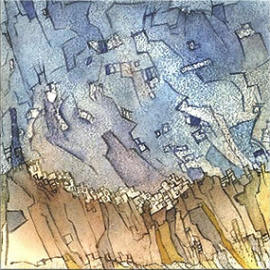
Village on the rocks, 1989, aquarelle
“…Borders are human inventions that artificially split the Nature’s flow.
Standing on one side of the border, I could feel the magic, healing
intangibility of Nature on the other side. Landscapes became accessible to my
eyes and imagination in their entirety. When I painted the villages of Lebanon
and the West Bank, I could encompass both sides and reconcile between them…”.
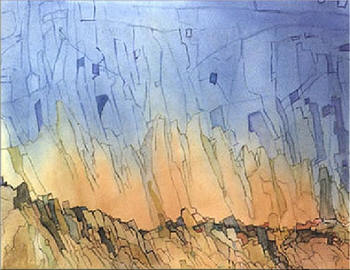
Edom Mountains, 1991, aquarelle
The wish for reconciliation is also apparent in other aspects of
Serfaty’s creations. In his aquarelles sky and earth fuse gently and villages
progressively emerge from earth. The human presence does not interfere with
Nature’s forces, but adapts and adopts its immense rhythm, becoming an integral
part of it. Serfaty’s use of aquarelle colors deeply emphasizes this process of
integration. The transparent colors spread out the contours and bind opposite
components of the painting. The white background on which transparent colors are
laid, functions as an inner source of light, that illuminates the whole painting
from within.
Lines have an important role in Serfaty’s aquarelles. They
regulate the space, define its components, and at the same time differentiate
among them. The lines also accumulate into topographical textures that vary in
their density and direction according to the depicted area. Thus earth is
usually characterized by a highly dense rhythm, while the sky, comprising spaced
lines, is perceived as a fresh, spiritual environment. In addition, the
morphological rhythm of the lines conveys a feeling of movement that seems to be
inherent to Nature itself. The rocks, dunes, sky, and earth are not static,
displaying a constant process of formation and development. Therefore, even in
the absence of a stated narrative, the aquarelles present a dramatic occurrence
anchored in the realm of Nature.
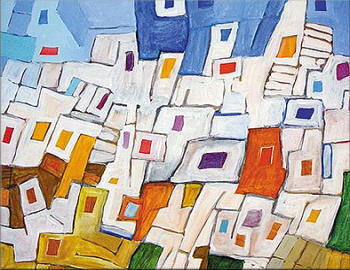
Tel
Aviv dancing, 2002, acrylic
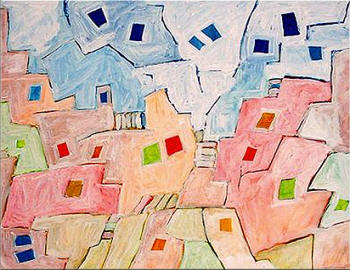
Tel
Aviv, 2002, acrylic
The atmosphere in Serfaty’s late acrylic paintings is of yet
another type. He intensively populates the space of the paintings with a large
number of diverse shapes, creating intricate urban landscapes, playing with the
illusion of spaciousness. Here is the tamed Nature contributing its amazing
colors and brightness to the urban maze. In the case of Serfaty’s acrylic
paintings, the pattern revealed is a joyful and intense one, full of strong,
saturated colors.
We could point out other characteristics of his acrylic works as
well. While his aquarelles constantly locate human action as part of Nature’s
eternal mechanisms, his acrylic paintings decisively emphasize human order,
presenting it as an alternative nature. The geometrical pattern of the houses,
that in the aquarelles was hidden among rocks, hills, dunes and sky, now
dictates the rhythm and the whole configuration of the paintings.
Light decidedly fulfills a major role in Serfaty’s paintings. Yet,
while in his aquarelles the light seemed to be diffusing from within the
painting, here the white color is thoroughly emphasized. As a result, it seems
that the light comes from outside the painting, being absorbed in its radiant
hues, enliven and softening them.
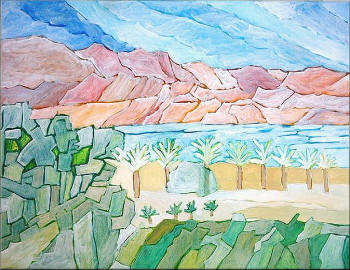 Contact:
serfaty@bezeqint.net
hagalil.com 06-01-04 |